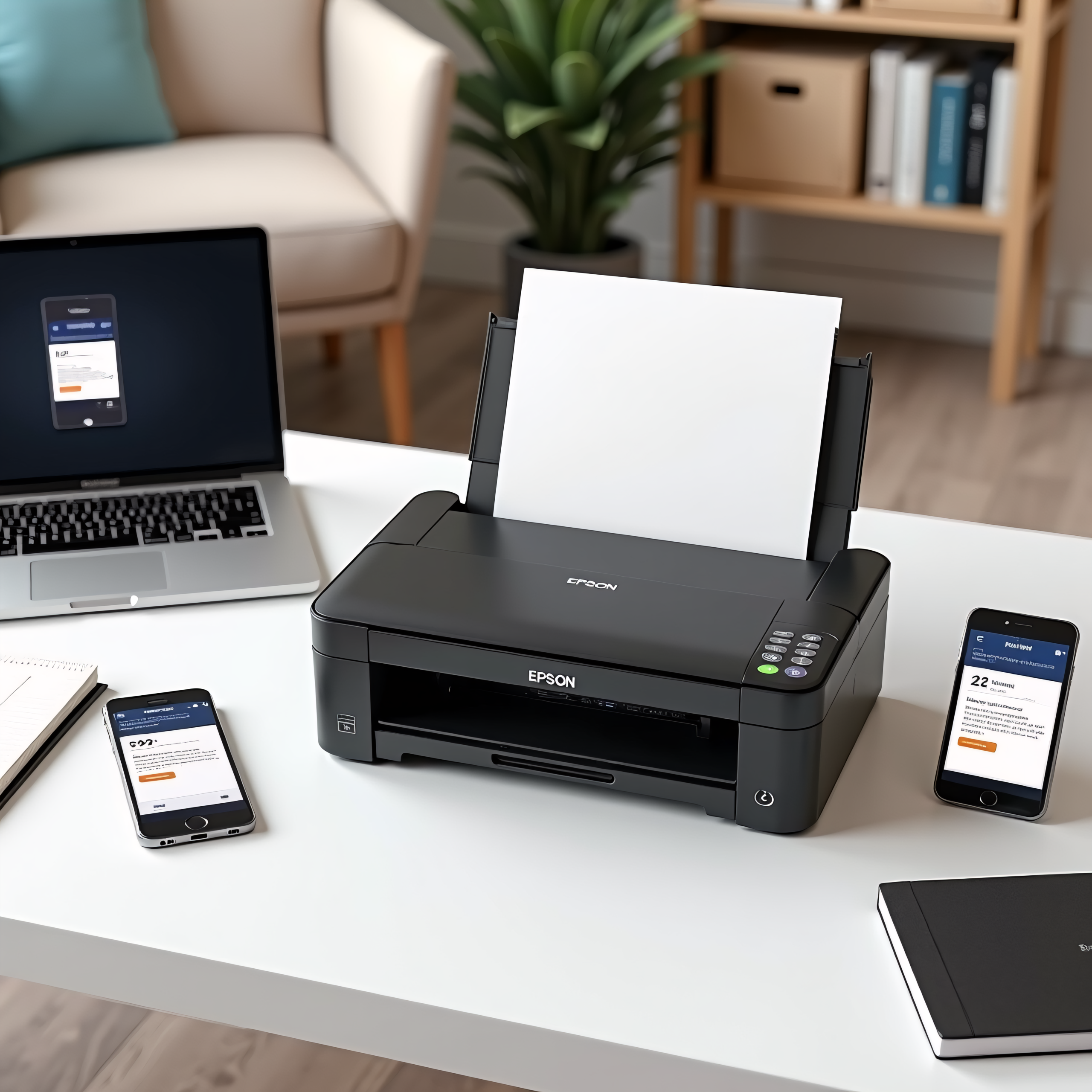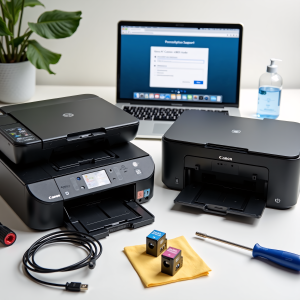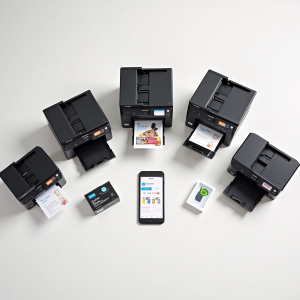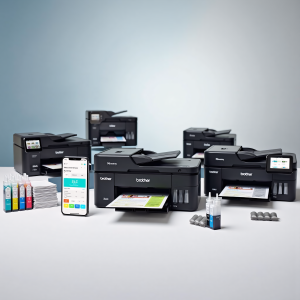estimated reading time: 9 minutes
Connecting Your World: A Comprehensive Guide to Epson Printer Connectivity
Did you know that over 70% of office printing issues stem from connectivity problems? In today’s increasingly mobile and cloud-based world, a reliable connection between your devices and your Epson printer is no longer a convenience – it’s a necessity. For too long, setting up and maintaining that connection has been a source of frustration for many. From deciphering cryptic error messages and wrestling with complex network settings to simply getting your phone to “see” the printer, the process can feel needlessly complicated.
But it doesn’t have to be.
This comprehensive guide aims to demystify Epson printer connectivity, walking you through everything from basic USB connections to the latest cloud-based printing solutions. We’ll break down the available options, explain how they work, and empower you to troubleshoot common issues with confidence. Whether you’re a tech-savvy professional or a casual home user, a seamless printing experience is within reach.
Table of Contents
- Understanding Your Connection Options
- Epson’s Native Connectivity Solutions
- Third-Party Alternatives & Universal Standards
- Advanced Networking with Epson
- Troubleshooting Epson Printer Connectivity
- Frequently Asked Questions
- Staying Connected: Mastering Your Epson Printer Experience
1. Understanding Your Connection Options
Let’s begin by exploring the fundamental connection methods available for your Epson printer. The most traditional, and often the most straightforward, is USB connectivity. This method provides a direct link between your computer and the printer, bypassing any network complexities. It’s ideal for situations where network access isn’t available or for prioritizing security, as data transfer is isolated. However, it requires a physical cable and limits access to only the connected computer.
Next, we have Wi-Fi connectivity, the cornerstone of modern printing convenience. This allows multiple devices on your network to access the printer wirelessly. Setting up Wi-Fi typically involves connecting the printer to your home or office network using your network password. Wireless printing offers flexibility and accessibility, but its performance can be affected by network congestion and range. Security is paramount here; ensure your Wi-Fi network is protected with a strong password and consider enabling WPA3 encryption for enhanced security.
A step up from standard Wi-Fi is Wi-Fi Direct. This creates a direct, peer-to-peer connection between your device and the printer, without requiring a router. It’s perfect for temporary connections or when a network isn’t available. Think of it as a mini-network established solely for printing. While convenient, Wi-Fi Direct typically supports fewer simultaneous connections than a full network setup.
Finally, cloud printing offers the ultimate in accessibility. This allows you to print from anywhere with an internet connection, using services that act as intermediaries between your device and the printer. Epson heavily invests in this area with Epson Connect, a suite of services designed to streamline your printing workflow.
2. Epson’s Native Connectivity Solutions
Epson Connect encompasses several key components. iPrint is a mobile app that allows you to print directly from your smartphone or tablet. Scan to Cloud enables you to scan documents and save them directly to cloud storage services like Google Drive, Dropbox, and OneDrive. Email Print assigns a unique email address to your printer, allowing you to print simply by sending an email attachment. These services are incredibly useful for mobile printing and remote access. They greatly simplify various printing tasks.
More recently, Epson introduced Smart Panel, a unified mobile app that combines the functionalities of iPrint and other features into a single, intuitive interface.Alongside this, ReadyPrint is a subscription service offering automatic ink delivery, ensuring you never run out of supplies. This is a convenient option for high-volume printing and can significantly reduce the hassle of manually ordering ink cartridges.
3. Third-Party Alternatives & Universal Standards
But Epson isn’t the only player in the connectivity game. Third-party solutions like PrinterShare offer cross-platform compatibility and advanced features, expanding printing options for a variety of devices. Printer’s Club provides a similar subscription-based ink delivery service, offering an alternative to Epson’s ReadyPrint. Universal printing standards like AirPrint (for Apple devices) and Mopria (for Android devices) ensure seamless printing from a wide range of mobile devices without requiring dedicated apps. These standards promote interoperability and convenience.
4. Advanced Networking with Epson
For users who desire granular control over their printer’s network settings, Epsonnet Config is a powerful tool. This utility allows you to configure network settings, assign static IP addresses, and monitor printer status. Using a static IP address can improve printing reliability by preventing the printer’s IP address from changing, which can disrupt connections. Proper network configuration is crucial for optimal performance and can minimize connectivity issues. Understanding subnet masks and gateway addresses can further refine network settings.
5. Troubleshooting Epson Printer Connectivity
Even with the best setup, connectivity issues can arise. Here’s a systematic approach to troubleshooting:
- Check Physical Connections: For USB connections, ensure the cable is securely connected to both the printer and computer.
- Restart Devices: A simple restart of your printer, computer, and router can often resolve temporary glitches.
- Verify Wi-Fi Credentials: Double-check that you’ve entered the correct Wi-Fi password.
- Update Drivers: Outdated Epson printer drivers can cause compatibility issues. Download the latest drivers from the official Epson website.
- Run the Network Troubleshooter: Most operating systems have built-in network troubleshooters that can diagnose and fix common problems.
- Check Printer Status: Ensure the printer isn’t showing any error messages or offline status.
- Firewall Settings: Rarely, firewall settings can interfere with printer connectivity. Ensure your firewall isn’t blocking communication with the printer.
- Router Firmware: Outdated router firmware can sometimes cause issues. Consider updating your router’s firmware.
6. Frequently Asked Questions
Q1: Why won’t my Epson printer connect to Wi-Fi?
Experiencing Epson Wi-Fi connectivity issues is common. First, ensure your printer and router are both powered on and within range. Double-check you’ve entered the correct Wi-Fi password during setup. Sometimes, restarting both devices resolves the problem. For persistent issues, ensure your Epson printer driver is up to date and consider running the Epson network setup utility for guided assistance.
Q2: How do I connect my Epson printer to my computer via USB?
USB connectivity is a reliable method. Begin by ensuring your Epson printer is powered on. Connect the USB cable to both the printer and your computer. Your operating system should automatically detect the printer and install the necessary Epson drivers. If not, download and install the drivers from the official Epson website, specifying your printer model.
Q3: What does ‘Printer Offline’ mean and how do I fix it?
“Printer Offline” indicates your computer isn’t communicating with your Epson printer. This can stem from a loose USB connection, a Wi-Fi signal interruption, or a driver issue. Check the physical connections first. Next, restart both your printer and computer. Finally, verify the printer is set as the default printer in your system settings and update your Epson printer software.
Q4: Can I print from my smartphone/tablet to my Epson printer?
Yes! Many Epson printers support mobile printing. Utilize Epson iPrint (iOS & Android) or Apple AirPrint for direct wireless printing from your smartphone or tablet. Ensure both your mobile device and printer are connected to the same Wi-Fi network. Some models also offer Epson Email Print for convenient document sending.
Q5: How do I set up Epson NetPrint to print directly from the internet?
Epson NetPrint allows remote printing without a computer. Register your Epson printer on the Epson website. You’ll receive a unique email address for your printer. Simply email documents as attachments to this address, and your printer will automatically print them – a great solution for accessing files remotely and avoiding printer connectivity headaches.
Q6: My Epson printer connects to Wi-Fi, but printing is slow. What’s the cause?
Slow printing with a wireless Epson printer can be caused by several factors. Check your Wi-Fi signal strength – a weak signal impacts speed. Larger documents or images require more data transfer time. Ensure no other devices are heavily using the Wi-Fi network. Consider a wired Ethernet connection for optimal performance if possible.
Q7: Where can I find the latest Epson drivers and software downloads?
The official Epson support website (https://epson.com/support) is the best source for Epson drivers and printer software. Navigate to the “Support” section, select your printer model, and choose “Drivers & Downloads”. Regularly updating your drivers ensures optimal performance and resolves potential Epson printer connectivity problems.
7. Staying Connected: Mastering Your Epson Printer Experience
We’ve covered a lot of ground in exploring the diverse world of Epson printer connectivity. From the reliable simplicity of USB connections to the freedom of wireless options like Wi-Fi and Wi-Fi Direct, and the convenience of cloud printing via Epson Connect and other solutions, understanding your choices is the first step towards a seamless printing experience. We delved into native Epson tools like iPrint and Smart Panel, alongside popular third-party options like PrinterShare, AirPrint, and Mopria, demonstrating how to tailor your setup to your specific needs. For power users, we even touched upon the advanced capabilities of Epsonnet Config and the benefits of static IP addresses.
Ultimately, the “best” connection method depends on your environment and workflow. However, equipping yourself with knowledge of all available options empowers you to troubleshoot issues effectively and maximize your printer’s functionality. Remember those common pain points we addressed? Often, a simple network reset or driver update can resolve frustrating connectivity problems.
Looking ahead, the trend towards further integration with mobile devices and cloud services will only accelerate. Expect to see even more sophisticated features within Epson Connect and potentially, expanded compatibility with smart home ecosystems. The future of printing is increasingly about accessibility and convenience – printing from anywhere, to anywhere.
Still battling Epson printer connection headaches? Don’t let connectivity issues slow you down! We’ve covered a lot, but if you’re facing a specific problem, check out A Comprehensive Guide to Seamless Printer Connectivity. Click here to explore The Ultimate Guide to Modern Printing



